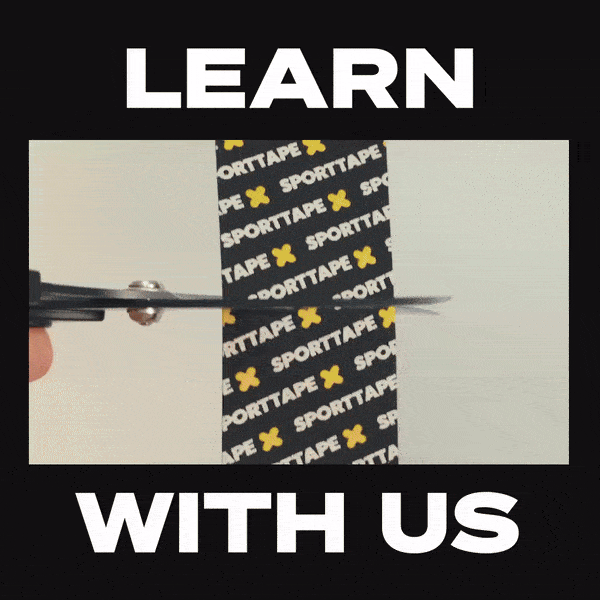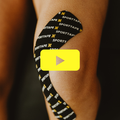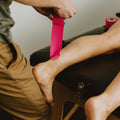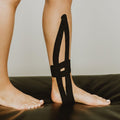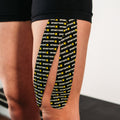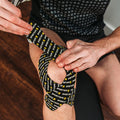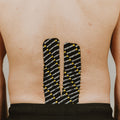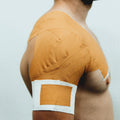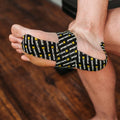Shin splints. The words cut like daggers, right?
If you run or know someone that runs, then you likely would have heard of the term shin splints. If you don't already know, they're a really common sports injury that can take quite a bit of time to heal. The best cure for them is rest and recovery. However, is there any way that Kinesiology Tape can help relieve some of the pain?
Let's take a closer look at exactly how tape might be your answer...
CAN KINESIOLOGY TAPE HELP SHIN SPLINTS:
WHAT IS KINESIOLOGY TAPE?
In short, Kinesiology Tape is a stretchy, cotton (or synthetic) tape designed to mimic the elasticity of the skin. It’s used by athletes and therapists all over the world to provide pain relief and support to joints, muscles and tendons.
Kinesiology Tape's rapidly become one of the most used products in sports medicine. Gracing the bodies of athletes of all levels strive to compete injury-free. They're still commonly made from cotton with various blends of nylon, lycra and other materials which are used to add stretch.
If you're interested in reading more about how Kinesiology Tape is used, why not check out our blog on how to get your roll to stick every time.
WHAT ARE SHIN SPLINTS?
Shin splints are one of the most common injuries for runners and I think anybody that has suffered with them, or even knows someone who has, will agree, they suck.
They basically refer to the pain and tenderness along, or just behind, the large bone in the lower leg. They tend to develop after particularly hard exercise or repetitive activity (like running). They can cause pain either on the front or outside of the shins or on the inside of the lower leg just above the ankle.
They often occur in athletes who have recently upped or changed their training routines in some way. For example, if you've just started running longer distances than your body is used to. The increased activity overworks the muscles, tendons and bone tissue.
Most cases of shin splints can be treated with rest, ice and other self-care measures. In a lot of cases, wearing proper footwear and modifying your exercise routine can help prevent shin splints from recurring. However, we would always recommend speaking to a physio first and foremost, if you're worried you may have developed shin splints.
CAN KINESIOLOGY TAPE HELP SHIN SPLINTS?
Let's start by saying, tape is not a miracle cure. It's a tool to help you rehab an injury, or in some cases, act as a pain relief to ensure you can continue to train and exercise as normal.
It's also worth noting that, before you start taping, it's important to establish whether you're taping to prevent developing shin splints, or to rehab them. If you're looking to prevent them, you're also going to want to ensure that you're always warming up and cooling down correctly, you're resting enough and if you do feel a niggle, give yourself a break!
If you're wondering whether Kinesiology Tape can be used to rehab your shin splints, the answer is yes. But, take everything in moderation. What it will do is stretch out the skin and create a level of pressure which can reduce pain for periods of time, if applied correctly.
There are a few different ways to actually tape up your shins, and sometimes you are going to want to experiment, in order to find the application that works the best for you. Let's get into the most common way to apply your Kinesiology Tape...
HOW TO TAPE YOUR SHIN SPLINTS:
STEP 1
Start by measuring 2 strips of Kinesiology Tape from just under your knee to the arch of your foot. Round the edges of the tape with a sharp pair of scissors and cut it into a Y strip.
STEP 2
Next, you're going to want to invert your foot slightly and stick the anchor (end 3-5cm) of one strip under the arch of your foot with absolutely 0% stretch. Stick the tails of your Y strip down with around 25% stretch around each side of the shin bone (tibia).
STEP 3
Finally, all you need to do is measure a short strip of tape across the front of your shin, and, like before, cut that into a Y strip too. Stick the anchor to the inside calf with 0% stretch again. From there, pinch and pucker the skin to lift it slightly. Lay the tails down across your shin with around 50% stretch.
And, as usual, wait at least 30 minutes before starting any sort of exercise.
DISCLAIMER
Before doing any of this, we have to remind you to please seek professional medical advice before applying Kinesiology Tape. Whether you’re a seasoned taping pro or a newbie, always get your knock fully assessed before applying anything.
And that's it! Everyone hates shin splints. Even if you've never had them. Naturally you're going to want to ditch them as soon as possible. But, it's important to deal with them correctly. So, if are planning on taping them up and have a question for us or one of our in-house physios, get in touch! We're happy to help.



























